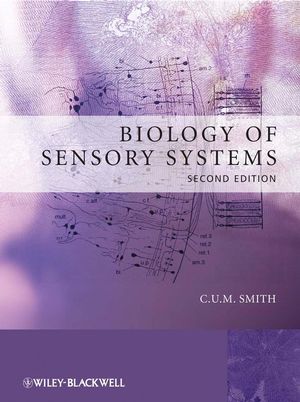Biology of Sensory Systems, 2nd EditionISBN: 978-0-470-51862-5
Hardcover
536 pages
February 2009
 Other Available Formats: Paperback
|
||||||
Preface to First Edition.
PART I: PRELIMINARIES.
Chapter 1: Elements.
1.1 Allosteric Effectors.
1.2 Membranes.
1.3 Membrane Signalling Systems.
1.4 Channels and Gates.
1.5 Concluding Remarks.
Chapter 2: Membranes, Action Potentials, Synapses.
2.1 The Measurement of Resting Potentials.
2.2 The Ionic Bases of Resting Potentials.
2.3 Electrotonic Potentials and Cable Conduction.
2.4 Receptor and Generator Potentials.
2.5 Sensory Adaptation.
2.6 Action Potentials.
2.7 Synapses and Synaptic Transmission.
2.8 Concluding Remarks.
Chapter 3: General Features of Sensory Systems.
3.1 Classification of the Senses.
3.2 Modality.
3.3 Intensity.
3.4 Adaptation.
3.5 Receptive Fields.
3.6 Maps of Sensory Surfaces.
3.7 Hierarchical and Parallel Design.
3.8 Feature Extraction and Trigger Stimuli.
3.9 Concluding Remarks.
Box 3.1 Hermann von Helmholtz.
Chapter 4: Classification and Phylogeny.
4.1 Systematics.
4.2 Classification into Six Kingdoms.
4.3 Unicellularity.
4.4 Multicellularity.
4.5 Protostomes and Deuterostomes.
4.6 Classification of the Metazoa.
4.7 Evolution of Nervous Systems.
4.8 Concluding Remarks.
Chapter 5: Genes, Genomics and Neurosensory Systems.
5.1 Introduction.
5.2 Comparative Genomics.
5.3 Genomes and Neurosensory Systems.
5.4 Concluding Remarks.
Box 5.1 Nomenclature of Genes and Proteins.
Part I: Self Assessment.
Part I: Notes, References and Bibliography.
PART II: MECHANOSENSITIVITY.
Chapter 6: Mechanosensitivity of Cell Membranes.
6.1 Mechanosensitive Channels in E. coli.
6.2 Detection of Osmotic Swelling by Hypothalamic Cells in Mammals.
6.3 Concluding Remarks.
Chapter 7: Kinaesthesia.
7.1 Kinaesthetic Mechanisms in Arthropods.
7.1.1 Stretch Receptors in Crustacean Muscle.
7.2 Kinaesthetic Mechanisms in Mammals.
7.3 Concluding Remarks.
Chapter 8: Touch.
8.1 Mechanoreception in Caenorhabditis Elegans.
8.2 Spiders.
8.3 Insects.
8.4 Tactile Receptors in Mammalian Skin.
8.5 Cerebral Analysis of Touch.
8.6 Plasticity of the Somaesthetic Cortex.
8.7 Concluding Remarks.
Chapter 9: Equilibrium and Hearing: The Uses of Hair Cells.
9.1 Anatomy and Physiology of Hair Cells.
9.2 Lateral Line Canals.
9.3 Evolution of the Vertebrate Ear.
9.4 Concluding Remarks.
Box 9.1 Biophysics of Outer Hair Cells.
Box 9.2 Genetics and Deafness.
Chapter 10: Cerebral Analysis.
10.1 The Mammalian Vestibular Pathway and Reflexes.
10.2 The Mammalian Auditory Pathway.
10.3 The Avian Auditory Pathway and the Mapping of Auditory Space by the Barn Owl.
10.4 The Mammalian Auditory Cortex.
10.5 The Bat Auditory System and Echolocation.
10.6 The Human Auditory Cortex and Language.
10.7 Lateralization and the Neuroanatomy of Language.
10.8 Language and the FOXP2 Gene.
10.9 Callosectomy and After.
10.10 Concluding Remarks.
Box 10.1 Broca andWernicke.
Part II: Self Assessment.
Part II: Notes, References and Bibliography.
PART III: CHEMOSENSITIVITY.
Chapter 11: Chemosensitivity in Prokaryocytes.
11.1 Chemosentivity in E. coli.
11.2 Concluding Remarks.
Chapter 12: Mammalian Chemo-Enteroreceptors.
12.1 Location of Mammalian Chemoreceptors for PaO2 and PaCO2.
12.2 Structure.
12.3 Physiology.
12.4 Biochemistry.
12.5 Concluding Remarks.
Chapter 13: Gustation.
13.1 Gustation in Insects.
13.2 Gustation in Mammals.
13.3 Concluding Remarks.
Chapter 14: Olfaction.
14.1 Insect Olfactory Systems.
14.2 Mammalian Olfactory Systems.
14.3 The Vertebrate Vomeronasal Organ (VNO) and Pheromones.
14.4 Concluding Remarks.
Part III: Self Assessment.
Part III: Notes, References and Bibliography.
PART IV: PHOTOSENSITIVITY.
Box I4.1 Bacteriorhodopsin.
Chapter 15: Invertebrate Vision.
15.1 Designs of Invertebrate Eyes.
15.2 Examples of Invertebrate Eyes.
15.3 Concluding Remarks.
Box 15.1 The Evolution of Opsins.
Box 15.2 Early Genetics of Eyes.
Chapter 16: The Human Eye.
16.1 Anatomy.
16.2 Embryology.
16.3 Detailed Anatomy and Physiology.
16.4 Movements of the Eyeball.
16.5 Concluding Remarks.
Box 16.1 Genetics of Cataract.
Chapter 17: The Retina.
17.1 Retinal Pigment Epithelium (RPE).
17.2 Retina.
17.3 Concluding Remarks.
Chapter 18: Visual Pathways and Cortices.
18.1 Visual Pathways into the Brain.
18.2 Primary Visual Cortex.
18.3 Extrastriate Cortices.
18.4 Face Recognition.
18.5 Prosopagnosia.
18.6 Concluding Remarks.
Box 18.1 The Reality of Cortical Columns.
Box 18.2 Blindsight.
Chapter 19: Other Vertebrate Visual Systems.
19.1 Visual Pigments.
19.2 Photoreceptors.
19.3 Tapeta.
19.4 Retinae.
19.5 Dioptric Apparatus.
19.6 Median Eyes.
19.7 Visual Pathways.
19.8 Visual Centres in the Brain.
19.9 Concluding Remarks.
Part IV: Self Assessment.
Part IV: Notes, References and Bibliography.
PART V: OTHER SENSES.
Chapter 20: Thermosensitivity.
20.1 Molecular Biology.
20.2 Poikilotherms.
20.3 Homeotherms.
20.4 Concluding Remarks.
Chapter 21: Minority Senses.
21.1 Infrared Radiation.
21.2 Polarized Light.
21.3 Electric Fields.
21.4 Magnetic Fields.
21.5 Concluding Remarks.
Chapter 22: Pain.
22.1 The Biological Significance of Pain.
22.2 Neurophysiology of Pain.
22.3 Neuropharmacology of Pain Pathways.
22.4 Referred Pain.
22.5 Gate Theory.
22.6 Concluding Remarks.
Part V: Self Assessment.
Part V: Notes, References and Bibliography.
PART VI: CODA.
Chapter 23: Summing Up.
23.1 Molecular Themes.
23.2 Cellular Themes.
23.3 Sense Organs.
23.4 Central Analysers.
23.5 Homeostasis.
23.6 Different Sensory Worlds.
23.7 From Abiotic to Biotic: Communication.
23.8 From Biotic to Social Communication: Mirror Neurons.
23.9 Concluding Remarks.
Chapter 24: Philosophical Postscript.
24.1 Descartes.
24.2 Qualia.
24.3 Tabula Rasa?
24.4 Epigenetic Epistemology.
24.5 Evolutionary Epistemology.
24.6 Beyond Descartes.
24.7 Concluding Remarks.
Part VI: Self Assessment.
Part VI: Notes, References and Bibliography.
Appendix: Some Techniques.
Acronyms and Abbreviations.
Glossary.
Index.



